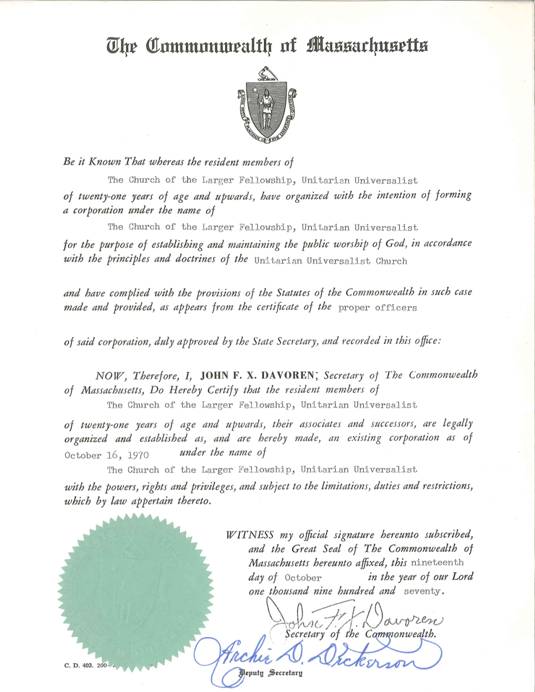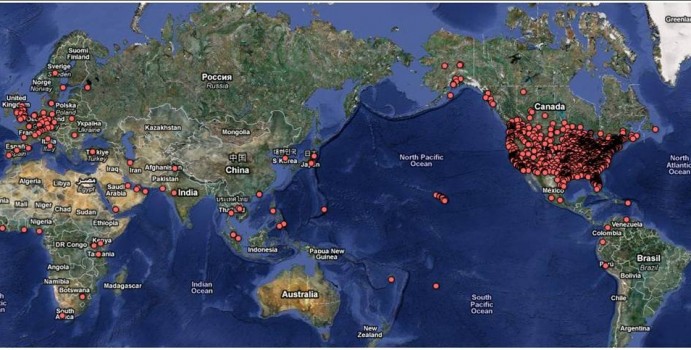History of the Church of the Larger Fellowship
May 7, 2015The story of the CLF begins with the human quest for religious fellowship and freedom across daunting frontiers of geographical, social, and spiritual separation. It is a story about the determination to share Unitarian and Universalist faith, and the evolution of a new paradigm for a “church without walls.” Such are the roots and the visions of the Church of the Larger Fellowship, then and now.
…a two-fold mission to provide a spiritual home and connection for isolated religious liberals as well as programs and services designed to promote the growth of Unitarian Universalism
In the 1800’s, Unitarians in Boston organized the American Unitarian Association, which dispatched itinerant ministers and missionary expeditions to fledgling midwest cities and distant prairies. Universalists devised similar outreach efforts. Liberal views in the form of letters and published tracts and pamphlets were carried on foot and horseback, house to house, and to Civil War soldiers in their camps. A Unitarian Women’s Alliance opened an office in Chicago and formed a relay system of letter correspondence called the “Post Office Mission.”
By the early 1900s, ‘ministry by mail’ had grown into a global network. It seems that the first person to conceive of such a network as ‘church’ was a Unitarian minister named William Channing Gannett. In 1904, he launched the ‘Church of All Souls’ and for forty years he mailed a monthly pastoral letter and a sermon to a scattered ‘fellowship’ of un-churched Unitarians. But with no means to join and no mechanism for growth, the church dwindled.
Eliot’s vision was for a ‘larger’ fellowship beyond the concept of geographical location, in his words, ‘a church by mail…A church in the fullest sense of the word, a church which will serve isolated religious liberals wherever they live.’
Rev. Frederick May Eliot, then the President of the American Unitarian Association, wanted to find a way to meet the needs of religious liberals serving in the armed forces. Eliot’s vision was for a ‘larger’ fellowship beyond the concept of geographical location, in his words, ‘a church by mail . . . a church in the fullest sense of the word, a church which will serve isolated religious liberals wherever they live.’ The church would have a minister — Dr. Albert Dieffenbach being the first — for pastoral correspondence. Members would not be names on a list, but active participants in the life, governance, and the financial support of the society, receiving the Association’s services especially tailored for home and field use. Institutionally, the CLF would be semi-autonomous in nature: a self-governing member congregation of the Association, but with its budget and leadership under the Extension Department of the AUA.
The founding of the Unitarian CLF took place on May 24th, 1944, at the annual meeting of the Association. The CLF’s purpose was stated as two-fold: “To provide a spiritual home for isolated Unitarians and their families, and to transfer the allegiance of its members to local Unitarian churches whenever and wherever possible.” The CLF was true to its purposes. Within four years, it grew from its original charter of 34 members to membership in every state in the USA, eight Canadian provinces, and nearly twenty countries. Geographically clustered CLF members were instrumental in starting new Unitarian fellowships — more than 400 by the end of the 1960s.
In conjunction with the AUA’s Department of Education, the “Church School by Mail” program was launched, with lessons adapted from the Beacon Series available on loan. In 1961, the Unitarians and Universalists merged to create the Unitarian Universalist Association. The Universalists had founded their own Church of the Larger Fellowship in 1947 under the auspices of the Universalist Church of America, and the leadership of the Rev. Clinton Lee Scott. With the denominational merger, the two CLFs merged, and the Church of the Larger Fellowship Unitarian Universalist was born. The new entity retained the semi-autonomous nature and dual purposes of its predecessors.
The post-merger time was one of increasing innovation and diversification. In response to requests for home educational materials for adults, the minister, Dr. George Marshall, created the popular “Independent Study Program.”
Another innovation was the “Directed Discussion Course” in which participants corresponded with a CLF director and each other. This new concept in interactive religious learning attracted the attention of people experiencing incarceration, and in 1965, a person at San Quentin became the first incarcerated member to join the church. The CLF was now producing a variety of youth publications and a handbook for ceremonies of marriage, baby dedications, and memorial services.

On September 24, 1970, the CLF became chartered and legally incorporated as a religious society in its own right. This was a critical turning point as the CLF claimed its brave heritage and resolved to move ahead — in the words of Dr. George Marshall — “holding in its own hand and guiding by its own light (its) destiny…in the service of a greater cause.”
The next few decades saw significant changes – many under the ministerial leadership of the Rev. Eugene Pickett — that would transform the CLF. Membership was broadened to include individuals affiliated with a local church or fellowship who by choice or circumstance also wanted a ‘church by mail.’ A new category of membership was extended to include small congregations and fellowships, signifying a move to programs and services especially designed to meet those needs. The dual purposes were recast as a two-fold mission to provide a spiritual home and connection for isolated religious liberals as well as programs and services designed to promote the growth of Unitarian Universalism. As yet another means to meet the needs of a ‘long distance’ membership, the succeeding ministry of the Rev. Scott Alexander introduced the popular ‘minister’s 800 line,’ increasing the accessibility of pastoral connection with the minister.
With the coming of the Rev. Jane Rzepka as Senior Minister in 1999, the CLF moved into the new millennium with a creative and contemporary approach. ‘Church by mail’ became church “on-line”; the ‘post office mission’ became a mission by website. Quest (CLF’s monthly worship publication), became available on-line and by podcast as well as by postal mailing. The church became increasingly de-centralized in its governance with board members from diverse geographical locations conducting business via teleconference, e-mail, and annual retreats. The CLF upgraded its technology and engaged a development director and a fundraising committee.
The Prison Ministry was started primarily to offer correspondence classes about Unitarian Universalism, provide pastoral care, and foster connection through its letter-writing (pen pal) program. Under the leadership of Chaplain Patty Franz, the Prison Ministry grew to 450 members.
As word of a liberal religious alternative to spiritual development spread through prison systems, it became clear the CLF Prison Ministry needed to find ways to scale its services. Under the direction of the Rev. Mandy Goheen, the CLF Worthy Now Prison Ministry Network was born in 2016. Worthy Now developed to serve two different needs: Of the 2,700 people who call the CLF their faith home, more than 1,200 (and growing) are living in prisons across the United States. Some were already UUs, but the majority learned about Unitarian Universalism’s saving message after being connected to the CLF by others who are incarcerated. Worthy Now helps extend the CLF’s reach to meet the demand for our faith among this population.
Second, we are called to be a community resource for UUs and others in liberal faith traditions, so that we can extend our reach far beyond those we already serve. Worthy Now seeks to create common space for developing and equipping a network of prison ministries to help those in the free-world better serve our incarcerated siblings in faith.
Just as the Worthy Now Prison Ministry network harkens back to the original Post Office Mission days of ministry to the most isolated, so does the CLF’s continuing ministry to those in military service. And, as a ‘Welcoming Congregation,’ the CLF provides an open door to members of the lesbian, gay, bisexual, transgender, intersex, queer, and questioning community. In addition, the CLF’s membership is more international than ever, with 250 members living outside of the United States in 53 countries, including Europe, Asia, the Middle East, Africa, and the South Pacific.

Rev. Meg Riley served with distinction as the CLF’s senior minister from 2010-2020. Her commitment to social justice, to innovative and collaborative leadership, to mentorship for up and coming ministers and to compassionate care for all CLF members shaped the CLF in profound ways. 2010 brought Facebook groups for deeper personal connection between members, and pastoral care responses to world-wide crises. In 2011 the CLF began offering online worship, and what had been an internship program expanded into the Learning Fellows program, offering learning opportunities and mentorship primarily to seminarians/ministers in formation, but also to a religious educator and an ordained minister. 2011 also saw the launch of the Quest for Meaning website, with an array of online resources including blogging. 2013-2014 the clfuu.org website was re-visioned and updated, and in 2014 Meg launched The VUU, an online UU talk show that over time came to center on matters of racial justice. In the same time period the CLF began to offer online vigils in response to national crises. In years that followed CLF covenant groups moved from an email-based format to real-time video conferencing, and the CLF joined with Launch Pad to create Faith Rocket, a subscription service that provides a wide range of resources to small congregations. Over the ten years that Meg served as senior minister, the prison ministry program became the Worthy Now Network, and our incarcerated membership grew from 400 to over 1,200. Through all the many changes Meg led with both humor and enthusiasm, prompting regular reference to what became the unofficial CLF motto: “Always in beta!”
In August 2020, Meg Riley retired, and the three-person multidisciplinary leadership team of Aisha Hauser, Christina Rivera, and Michael Tino took the helm of the CLF. This Lead Ministry Team models collaborative, multicultural, innovative leadership as CLF moves forward.
The CLF of the 21st century is proud of its place as a refuge and a transitional community for isolated liberals wherever they are, and however they find us. The CLF is there for people seeking the light of religious freedom in parts of the world unfriendly to the concept. Having embraced its place as the largest and most far-reaching congregation in the UU world, the CLF strives for excellence, relevance, and innovation across the still daunting frontiers of geographical, social, and spiritual separation. It is, by its heritage and its vision, a church without and beyond walls, a church in every sense of the word.
Support the CLF
Can you give $5 or more to sustain the ministries of the Church of the Larger Fellowship?
If preferred, you can text amount to give to 84-321
Newsletter Signup
About
Quest for Meaning is a program of the Church of the Larger Fellowship (CLF).
As a Unitarian Universalist congregation with no geographical boundary, the CLF creates global spiritual community, rooted in profound love, which cultivates wonder, imagination, and the courage to act.
Contact
Church of the Larger Fellowship Unitarian Universalist (CLFUU)
24 Farnsworth Street
Boston MA 02210



